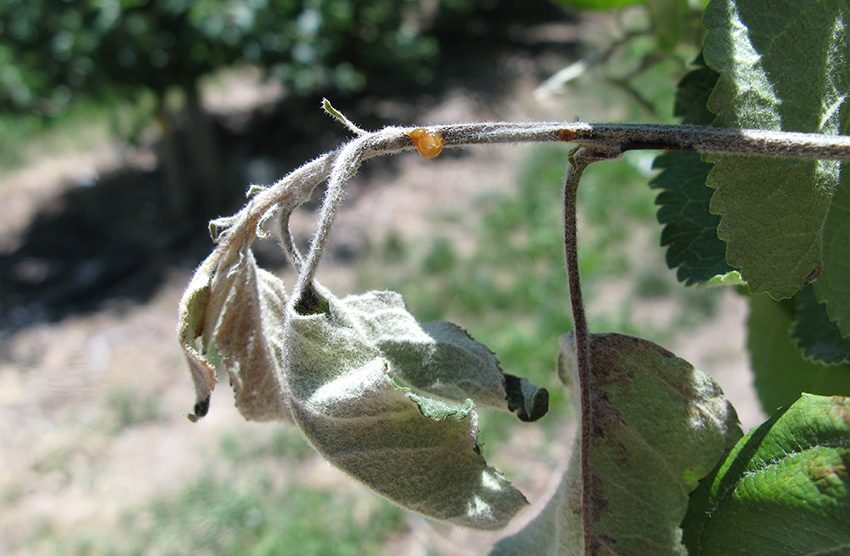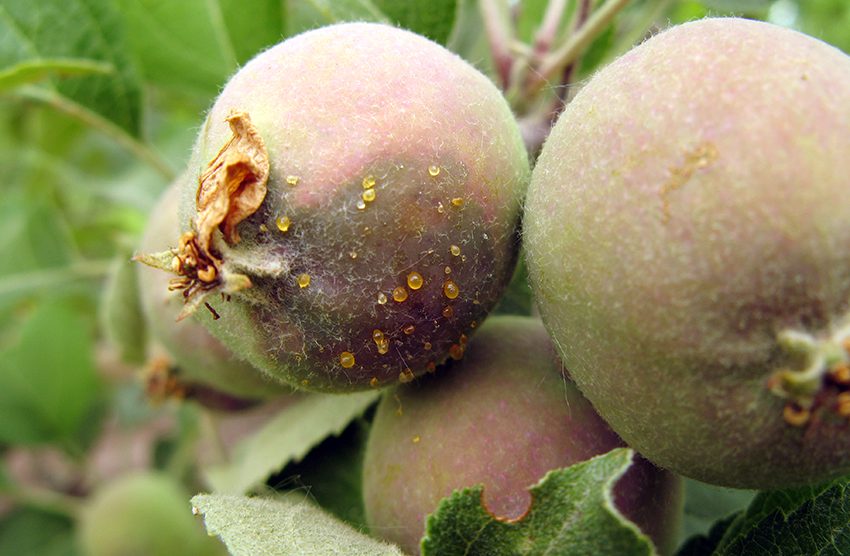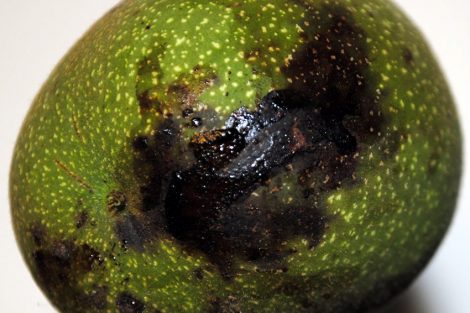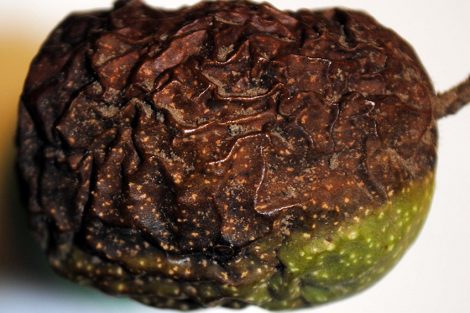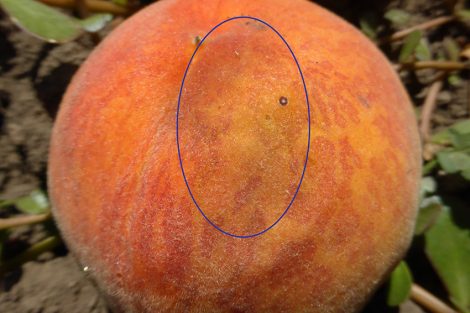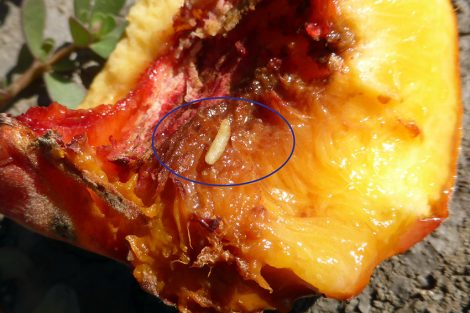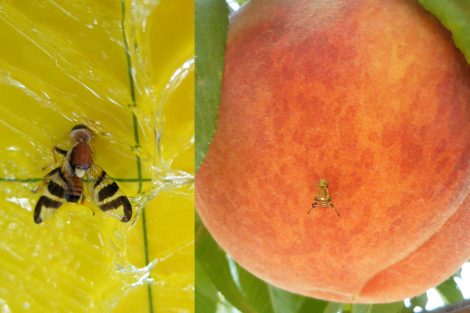In this Issue
- Codling moth: updated spray dates table
- White apple leafhopper: adults active now
- Fire blight: check for new shoot infections in a week from the recent storms
- Peach twig borer: updated spray dates table
- Walnut husk fly: treatment dates coming up
- Obliquebanded leafroller: spray dates for commercial producers in Utah County
- Greater peachtree borer: treatment time coming up
- Coryneum blight: recent rains may have caused new infections
- Western cherry fruit fly: be mindful of pre-harvest intervals
APPLE, PEAR
Codling Moth
Note the time gap between end of first generation and start of second generation (on the table in the link below).
View a pdf of the spray timing table. Be sure to read the instructions at the top of the page, for how to read the table. At most sites, codling moths are finishing up the time of rapid egg hatch.
In high population areas, time your last spray of the first generation to protect fruit up to the end of egg hatch as shown on the table.
Your next application should occur at the date for the start of second generation egg hatch, or if you can tolerate higher injury or have a low population, apply your next spray at the start of “second generation peak egg hatch”.
Treatment
- See this post for spray options for backyard growers (scroll down to Codling Moth heading and see table).
- Options for commercial growers.
White Apple Leafhopper
Adults are active now; their offspring (nymphs) will be active in approx. 3 weeks
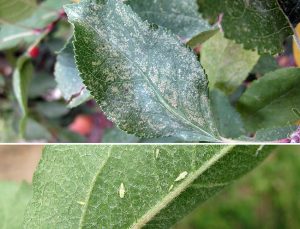
Leafhopper adults are active now, appearing as “white flies” that fly around when foliage is disturbed. Leafhoppers are a minor pest of apples (and cherry) and rarely cause economic damage. They feed on foliage with piercing-sucking mouthparts which causes stippling (tiny white spots), but this does not harm the tree or affect fruit size or yield.
Adults will soon begin to lay eggs, and the nymphs that hatch will also feed on foliage. But because nymphs are wingless, this pest is easier to manage by targeting this life stage. Most nymphs and adults are found on the undersides of the leaves.
Treatment
Treatment is usually warranted when the leafhoppers have been a nuisance at apple-picking time in previous years.
- Residential: Insecticidal soap (many brands) or products containing pyrethrin are organic options, but must come into contact with the leafhoppers, which are on the undersides of the foliage. Good coverage is important and application should be repeated in 7 days. A few options for conventional treatment of codling moth also work on leafhoppers (Spectracide Triazicide, GardenTech Sevin, and related).
- Commercial: Options for leafhopper can be found by clicking here for apple, and here for cherry
Fire Blight
Recent strong storms may have caused new infections on shoots
In about a week, inspect trees that have had fire blight in the past for new infections on the succulent shoots. The recent storms which brought strong downpours, wind, and in some cases, hail, had the potential to damage foliage. If fire blight was present at the site, the fresh foliage wounds could possibly have become infected.
If infections are found, prune them out as soon as possible, 12 inches into healthy wood. Wipe pruners with disinfecting wipes between cuts. Remove the pruning debris from the area unless conditions have become very hot and dry and the debris will not be wetted by irrigation water.
PEACH/NECTARINE, APRICOT, PLUM
Peach Twig Borer
First generation egg hatch is ending soon in certain locations.
After fruit softens, twig borer larvae will enter the fruit to feed. View a pdf of the spray timing table.
Second generation of peach twig borer egg hatch will begin in mid-July for most areas. Fruit becomes more susceptible to attack by twig borer larvae when it is softer, and one application at the beginning of second generation should suffice for most areas.
Treatment options for peach twig borer are the same as for codling moth.
Walnut Husk Fly
Hosts include nuts of walnuts and fruits of peach and apricot; see dates below
Emergence of adult husk flies will begin in the next 5 to 10 days in areas of northern Utah. From then, flies will continue to lay eggs until late September, with peak egg-laying to occur in mid-August.
To avoid husk flies all together, spray at regular intervals until peach/apricot harvest or for walnuts, when they are within one month of harvest. Eggs laid later than this will not have time to develop and cause damage.
When maggots feed on young, developing walnuts, the walnut shrivels, turns moldy, and drops prematurely. Later feeding (late Aug. – Sept.) will not affect the kernel, but will result in a husk that is stained black and a hull that is difficult to separate from the nut. The maggots feed for 3 to 5 weeks before dropping to the soil to pupate.
If you don’t mind the extra work of removing the damaged husks, treatment is not necessary because the kernel is usually not damaged. Infested nuts can be stored in a damp burlap bag for 2 to 3 days to help with husk removal.
Start Treatment Dates:
- southern Box Elder, Davis, Weber, Salt Lake City, Utah counties along the I-15 corridor: June 19 – June 21
- northern Box Elder, Tooele, Iron counties and similar areas: June 23 – 26
- Cache, Juab: June 28 – 30
Treatment
The primary option for both commercial and backyard trees is the organic product, spinosad (Captain Jack’s, Gardens Alive Bull’s Eye, Monterey, Entrust, Success), which is applied every 7 days. Make sure you cover the entire tree.
Another option is using a bait with spinosad. The bait attracts the adult flies to feed on the product, and the spinosad kills the flies. GF-120 is a prepared bait, but is only sold in gallon-sized containers for at least $100. Backyard growers could consider mixing a bait solution of the spinosad concentrate with about 4 to 6 tablespoons of molasses per gallon of water applied.
The GF-120 or homemade spray mix does not need to cover the entire tree. Instead, it should be applied as evenly spaced, large droplets.
Obliquebanded Leafroller – Commercial Growers in Utah County
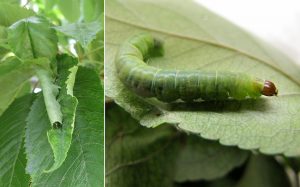
The Utah IPM Program has leafroller monitoring traps in several orchards across northern Utah, and moths were caught between May 29 and June 2 for southern Utah County locations. Larvae feed for four to six weeks, and may be a contaminant during tart cherry harvest. Larvae can also cause damage to the fruit of a number of crops, but this is minor. A second summer generation of larvae will emerge in August.
The best way to monitor for pest activity is to look for larvae in rolled leaves that are webbed together. Open or separate the leaves and look for a shiny green larva with a brown head.
Most growers use an insecticide that targets young or newly hatched larvae. An example is the insect growth regulator Intrepid, which as a bonus also kills existing egg masses. Several other conventional products are effective, including Delegate, Altacor, pyrethroids, Success, or Voliam Xpress.
For organic treatment, use Entrust (spinosad) or Deliver (Bt). Deliver has a short residual (about 4-5 days, and should be applied with good coverage, since it must be consumed.
Products that have 14 or more days of residual (Delegate, Altacor, pyrethroids, etc.) may require 1 additional application, while products like spinosad or Bt may require 2 or 3.
Application Timing:
- American Fork: June 21 – 24
- Lincoln Point: June 23 – 25
- Payson: June 22 – 25
- Santaquin: June 24 – 27
- West Mountain: June 23 – 26
Greater Peachtree Borer
Spray lower trunks in Wasatch Front, Iron County, and northern Washington county locations starting June 19 – 22
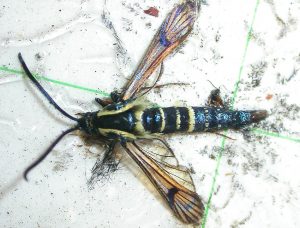
Spraying the lower trunks (10″ up plus exposed roots) with an insecticide will kill any eggs that are laid by the female moths. Otherwise, a larva will hatch and immediately bore into the tree trunk and feed on the inner bark and cambium.
There they stay until the following spring, when the gumming mixed with frass at the base of the trunk is most notable.
The range of first treatment date (or date where mating disruption should be hung) for other locations is:
- Cache, Carbon, Summit, Uinta, Wasatch counties: June 26 – July 3
Treatment
Female moths are actively laying eggs all summer long, so keep the trunk protected through September. Peach trees younger than 5 years are the most vulnerable.
- Residential: permethrin (such as Bonide Eight Vegetable, Fruit, & Flower; Hi-Yield Garden & Farm Insect Control; Hi Yield Indoor/Outdoor, etc.)
- Apply at the appropriate timing, and repeat once per month, with the last application in September.
- Organic options are products that contain either pyrethrin or azadirachtin (BioNeem), but need to be applied weekly.
- Options for commercial growers who have not used mating disruption: click here.
Coryneum Blight
Recent rains may have caused infections; consider a curative fungicide application
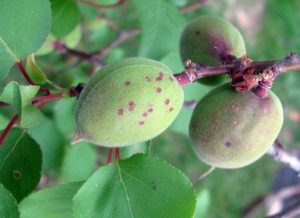
Infections may occur on foliage or fruit when temperatures are in the 70s with approximately 4 hours of rainfall. During the recent storms, temperatures were cooler than that in most locations, so the risk of new infections was not severe.
Brand new infections on fruit appear as a purple or tan lesions with a bit of ooze. Fruits may be infected multiple times.
Fruit infections that occur early in the season will turn into scabby spots by harvest. Infections that occur later in the season, after fruits ripen, will cause soft, sunken, grayish lesions.
Coryneum blight can be difficult to eradicate because it overwinters in buds, and the fungus can survive in infected twigs for up to three years. A grower must be dedicated to eradication, and combine annual pruning of diseased twigs with a regular spray program.
Fall is the optimal timing for treatment with copper, ziram, or captan, at 50% leaf drop. However, some fungicides applied after a rain event have some curative activity.
The weather is predicted to become warm and dry after today, so new infections will slow down. But when rains are expected, plan to apply a preventive fungicide up to harvest.
Treatment
- Residential: Spectracide Immunox; Monterey Fungi-Max, captan
- Commercial: options for peach, and apricot
CHERRY
Western Cherry Fruit Fly
Be mindful of pre-harvest intervals
Sweet cherries are nearing harvest in certain areas. If one last treatment is needed, it must be a product with a short pre-harvest interval, such as Safer BioNeem (0 days) or spinosad (7 days).
Treatments on tart cherry have recently begun.
Treatment Options – Backyard Growers
Conventional:
- Malathion (malathion): pre-harvest interval is 14 days
- Garden Tech Sevin (zeta-cyfluthrin); pre-harvest interval is 14 days
- Bonide Fruit Tree Spray (carbaryl): pre-harvest interval is 14 days
- Spectracide Triazicide (gamma-cyhalothrin): pre-harvest interval is 14 days
Organic:
- Fertilome / Gardens Alive / Bull’s Eye / Monterey (spinosad): pre-harvest interval is 7 days
- Safer BioNEEM (azadirachtin): every 7 to 10 days; pre-harvest interval is 0 days
Treatment – Commercial Growers
- Commercial growers, click here

